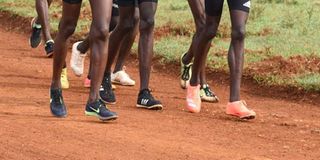Running with breasts a very weighty issue

Athletes train in the past.
What you need to know:
- This is food for thought for local researchers. There is need to look at the limits of the breast skin to understand the potential risks of exercising without appropriate breast support.
As we continue imagining an uncertain post-Covid-19 future, there is another issue threatening the fragile journey towards equality in sports: Breasts. What a weighty issue it is to run with breasts!
Earlier this week, I stumbled upon a podcast by Dr Nikki Brown, an Associate Professor in Female Health at St Mary's University in Twickenham, who was sharing the findings of his research paper titled “the Influence of the Breast on Sport and Exercise Participation in School Girls in the UK”.
She found out that only 12 per cent of 14-year-old girls in the UK achieve the recommended exercise guidelines -- and it is reported that breasts might be one of the contributing factors.
That statistic caught my attention, so I went online to see what more findings there were on the matter.
Think about it. During play, when faced by an onrushing opponent in the fight for the ball, women have to think first about keeping the ball, but also about protecting their breasts from injury as well as adjusting their sports bras.
Amanda Hess, an American journalist, presented an array of evidence, research, and interviews with athletes and experts and wrote in the ESPN magazine: A mounting body of evidence suggests that they (breasts) pose a serious challenge in nearly all corners of competition. Gymnasts push themselves to the brink of starvation to avoid developing them. All sorts of pro athletes have ponied up thousands of dollars to surgically reduce them. For the modern athlete, the question isn't whether breasts get in the way — it's a question of how to compete around them.
Sounds about right, but the only oversight in Amanda’s statement is that apart from the issue of big breasts being a hindrance to athletic performance, female athletes also worry about the embarrassment their breasts can bring, and the potential for ogling and online trolling.
The science is all there. The breast structures are quite weak mechanically, so when women jog, they contend with breast movement of up to 20 centimetres on average, and that movement has a number of negative consequences.
Additionally, each breast weighs about half a kilogramme, and one big negative consequences is that it hurts.
The other practical thing is that most women experience breast pain every month that is linked to their menstrual cycle and the hormonal changes within the breast. Yet many female athletes have reported attending training as required, even when on their menses!
Another weighty consequence is that constant stretching of the breast’s weak supporting structures causes them to permanently change their original position, and the breast sags, just as it happens with the skin when it stretches beyond 80 per cent of its original length.
This is food for thought for local researchers. There is need to look at the limits of the breast skin to understand the potential risks of exercising without appropriate breast support.
The findings could be crucial in effecting better management of breast for athletes, which could lead to better performance and also encourage more female teenagers to take up sports.





